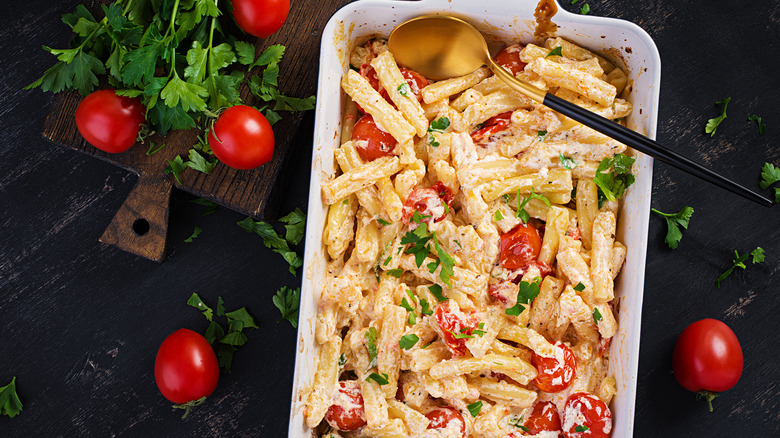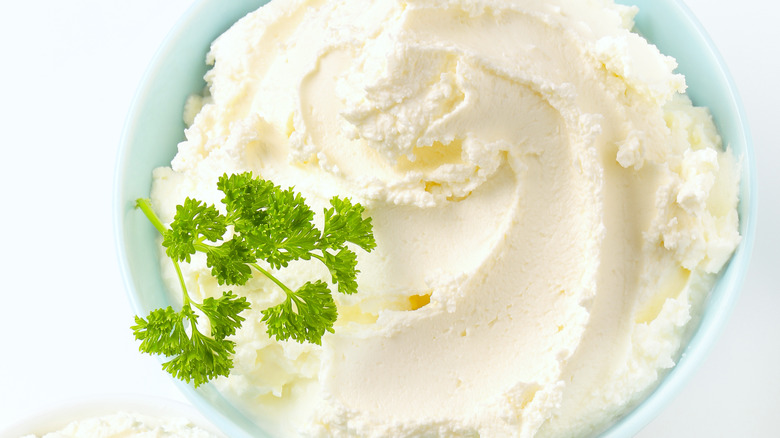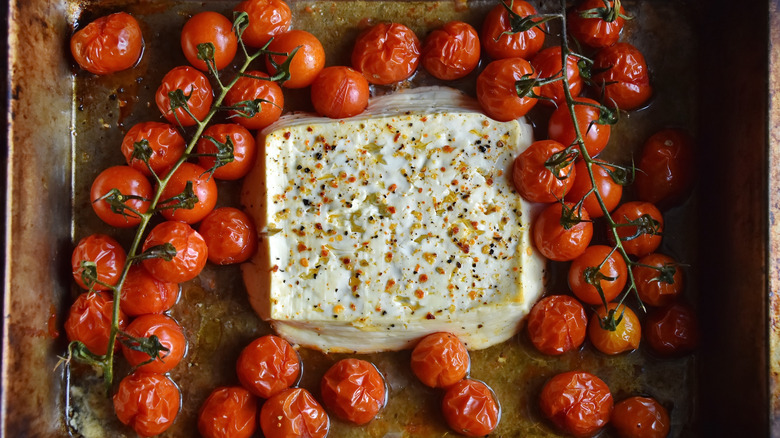For The Most Luxurious Feta Pasta, Stir In Some Cream Cheese
Feta pasta brings to mind a dish full of Mediterranean delights to the senses: salty, briny, rich, creamy, carb-y goodness. The viral baked feta pasta of TikTok looks like it should be the answer to all of those dreams, but there's one problem with the reality of this. Feta doesn't melt, so it can't live up to the creaminess the imagination desires.
To amp up the creaminess, there's a secret weapon in the dairy aisle refrigerators — one you might already have in your fridge: cream cheese. By adding cream cheese, feta pasta immediately attains a luxe creaminess you can't get with just feta cheese. The cream cheese melts down beautifully and, because it has a light, mildly tangy flavor, it accentuates and carries the tang and bold flavor of the feta cheese without overpowering it.
It's a super easy addition, too. Instead of just baking the block of feta with the tomatoes, cube up some cream cheese and mix it right in with the tomatoes around the feta block. When you pull the dish out of the oven and stir it up, the cream cheese will melt right into the tomatoes and be a decadent vehicle for that feta. The more cream cheese you add, the thicker and creamier it will be — but be aware that adding too much can drown out the bold flavor of your feta. To maintain the integrity of the flavor, don't add more cream cheese than feta cheese.
The secrets of cheese meltiness
You may be thinking, "But if feta doesn't melt, how does any of this dish work in the first place?" The answer is a bit pedantic but important: Feta softens, but it doesn't melt. This is important in the case of the baked feta pasta because it can be a bit grainy rather than smooth and decadent (that's where the cream cheese comes in).
Cheese melts better or worse as a factor of its pH and how the curds were formed. Cheese is really just coagulated proteins. Melting is the process of relaxing those bunched-up protein strands, but there's a happy medium of pH for maximum meltability: between 5.0 and 5.4. The more acidic and therefore lower pH a cheese is, like feta, which generally has a pH between 4.6 and 4.9, the more inhibited melting is.
Cream cheese is a special case. It has a pH similar to feta in the 4.6 to 4.9 range, which should — theoretically — make it similarly non-melting. The difference with cream cheese is how it's made. Unlike most other cheeses, it's made with lactic acid, not the enzyme rennet, giving it a different structure. This is largely why it's creamy and soft; the curds are so small that when it softens, it seems like it's melting. Is this a different kind of melting than a stretchy mozzarella or cheddar? Sure! But for the purposes of creamy feta pasta, it counts.
Making decadent feta pasta
The basic structure of making this feta pasta is the same pasta that Gordon Ramsay loves. You're nestling a block of feta into the center of a bunch of cherry tomatoes, then adding olive oil, red pepper flakes, salt, pepper, and garlic. The only real difference is that you're adding cubes or chunks of cream cheese along with the tomatoes. But since you're adding more richness to the dish, it's capable of carrying more bold flavors alongside the tomatoes and garlic, if you care to deviate and get creative.
To lean into the Mediterranean aspect, you can add chopped kalamata olives, sundried tomatoes, and even chopped artichoke hearts to bulk up the pasta. To make a very springy dish, consider adding asparagus cut into inch-long pieces to the tomatoes, and/or some freshly shelled English peas. You can add thin slices of whole lemons on top as it bakes to amp up the tanginess, then use the residual heat of the dish as it comes out of the oven to wilt handfuls of fresh spinach and serve with grilled chicken, salmon, or even shrimp. Bake in some chopped broccolini, and if you have excess caramelized onions hanging around, add some of those when the cheese comes out of the oven and then serve it with steak. Because you're rebalancing the flavors and textures of the feta pasta, the possibilities are endless.


